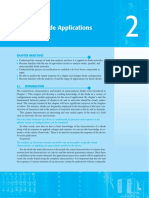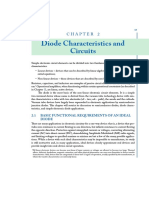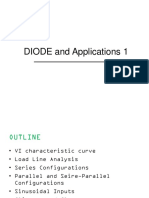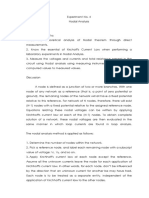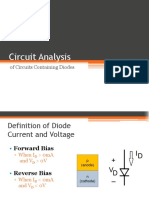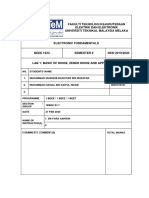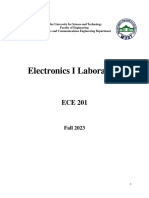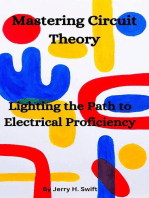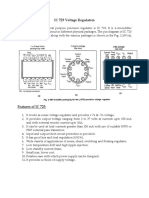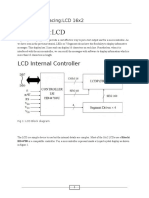Chapter 3 - Semiconductor PN Junction Diode: Series Diode Configuration With DC Inputs
Chapter 3 - Semiconductor PN Junction Diode: Series Diode Configuration With DC Inputs
Uploaded by
Vince Lester DP. De CastroOriginal Description:
Original Title
Copyright
Available Formats
Share this document
Did you find this document useful?
Is this content inappropriate?
Report this DocumentCopyright:
Available Formats
Chapter 3 - Semiconductor PN Junction Diode: Series Diode Configuration With DC Inputs
Chapter 3 - Semiconductor PN Junction Diode: Series Diode Configuration With DC Inputs
Uploaded by
Vince Lester DP. De CastroCopyright:
Available Formats
CHAPTER 3 - SEMICONDUCTOR PN JUNCTION DIODE
• Continuation….
• Diode circuits analysis
o Series configuration
o Parallel configuration
o Series – parallel configuration
• Light emitting diode
SERIES DIODE CONFIGURATION WITH DC INPUTS
In this section the approximate model is utilized to investigate a number of series
diode configurations with dc inputs. The content will establish a foundation in
diode analysis that will carry over into the sections to follow. The procedure
described can, in fact, be applied to networks with any number of diodes in a
variety of configurations.
For each configuration the state of each diode must be first to determined, which
diodes are “ON” and which are “OFF”? Once determined, the appropriate
equivalent can be substituted and the remaining parameters of the network
determined.
In general, a diode is in the “ON” state if the current established by the applied
sources is such that its direction matches that of the arrow in the diode symbol,
and Vd ≥ 0.7V for silicon and Vd ≥ 0.3V for germanium.
Keep the following in mind for the analysis to follow:
1. An open circuit can have any voltage across its terminals, but the current is
always 0A.
2. A short circuit has a 0-V drop across its terminals, but the current is limited
only by the surrounding network.
PROBLEMS:
1. For the series diode configuration. Determine Vd, VR, and Id.
2. Repeat example 1 with the diode reversed.
3. For the series diode configuration of figure. Determine Vd, VR, and Id.
4. Determine Vo and Id for the series circuit.
5. Determine Id, Vd, and Vo for the circuit.
6. Determine I, V1, V2, and Vo for the series configuration.
PARALLEL AND SERIES - PARALLEL CONFIGURATIONS
The methods applied in the previous series configuration can be extended to the
analysis of parallel and series-parallel configurations. For each area of application,
simply match the sequential series of steps applied to series diode configurations.
PROBLEMS:
1. Determine Vo, I1, ID1, and ID2 for the parallel diode configuration of Fig.
2.30.
2. Determine the current I for the network of Fig. 2.32.
3. Determine the voltage Vo for the network of Fig. 2.34.
4. Determine the currents I1, I2, and ID2 for the network of Fig. 2.36.
Note: these problems were taken from
ELECTRONIC DEVICES AND CIRCUIT THEORY
By:ROBERT BOYLESTAD
LOUIS NASHELSKY
To be continued….
Prepared by: albertians
You might also like
- Nanometrical Devices - MOSFET in Synopsys SentaurusDocument15 pagesNanometrical Devices - MOSFET in Synopsys SentaurusJuan VALVERDENo ratings yet
- Week 3 - Semiconductor Devices: Part 1: Background QuestionsDocument3 pagesWeek 3 - Semiconductor Devices: Part 1: Background QuestionsMark CyrulikNo ratings yet
- Diode Applications: Chapter ObjectivesDocument23 pagesDiode Applications: Chapter ObjectivesFranco Faza ZamoraNo ratings yet
- Lab 2 - Diode CharacteristicsDocument7 pagesLab 2 - Diode CharacteristicsFasil EndalamawNo ratings yet
- EE Lab Manuls Fast NuDocument88 pagesEE Lab Manuls Fast NuMuhammad SaadNo ratings yet
- Syllabus Cusat 2006 Admission PDFDocument71 pagesSyllabus Cusat 2006 Admission PDFNeha KarthikeyanNo ratings yet
- Boylestad Electronic Ch2Document74 pagesBoylestad Electronic Ch2ShannonDaiiannaDalgoNo ratings yet
- Series Diode Configuration With DC Inputs Example:: 0.7 V For Silicon and V 0.3 V For GermaniumDocument2 pagesSeries Diode Configuration With DC Inputs Example:: 0.7 V For Silicon and V 0.3 V For Germaniumeric labordoNo ratings yet
- ECE 2262 - Fundamentals of Electronic Circuits - Module 3Document4 pagesECE 2262 - Fundamentals of Electronic Circuits - Module 3Rafael Jayson AñoraNo ratings yet
- Series Diode Configurations With DC Inputs: Experiment No. 3 ObjectiveDocument3 pagesSeries Diode Configurations With DC Inputs: Experiment No. 3 ObjectiveBogs SorianoNo ratings yet
- Chapter 2 Diode Applications PDFDocument122 pagesChapter 2 Diode Applications PDFObama binladenNo ratings yet
- Diode, BJT, Zener, MosfetDocument10 pagesDiode, BJT, Zener, MosfetSundar Krishna MoorthyNo ratings yet
- Chapter 1 Diode Circuit Ee b2 76 PDFDocument50 pagesChapter 1 Diode Circuit Ee b2 76 PDFajay RCBNo ratings yet
- Diodes and Their Applications: IV.1. The PN Junction (Diode)Document14 pagesDiodes and Their Applications: IV.1. The PN Junction (Diode)Frew FrewNo ratings yet
- Fundamentals of Electronics Book 1-DidosDocument69 pagesFundamentals of Electronics Book 1-DidosJesús Aldair Lozano SuárezNo ratings yet
- Chapter 1 Diode Circuit Final 24 PDFDocument45 pagesChapter 1 Diode Circuit Final 24 PDFMahankali SwathiNo ratings yet
- A51c146 29c4 11ed b197 02b17be2b734 - 20220910132547Document4 pagesA51c146 29c4 11ed b197 02b17be2b734 - 20220910132547narayanas1807No ratings yet
- Bachelor of Engineering Honours Degree in Telecommunications EngineeringDocument9 pagesBachelor of Engineering Honours Degree in Telecommunications EngineeringBRIGHT TZZZY CHINGWENANo ratings yet
- Electronic Device Lab 1 Diode CharacteristicsDocument9 pagesElectronic Device Lab 1 Diode CharacteristicsVy NguyễnNo ratings yet
- Lecture Presentation 1Document105 pagesLecture Presentation 1Ahmet SancakNo ratings yet
- Eee212 Homework2 240509 201627Document13 pagesEee212 Homework2 240509 201627cheggpashaNo ratings yet
- Diode Characteristics LabDocument5 pagesDiode Characteristics LabShuvodip Das100% (2)
- Electrical Devices Exp 1 - Determination of Characteristic Curve of A DiodeDocument13 pagesElectrical Devices Exp 1 - Determination of Characteristic Curve of A Diodeivy.faraezi15No ratings yet
- 1 W7 Yavy 9 DN EDksrhrpukDocument7 pages1 W7 Yavy 9 DN EDksrhrpukmohinikushwaha736No ratings yet
- Chapter2 DIode SEE2063Document43 pagesChapter2 DIode SEE2063VladMihaiVladMihaiNo ratings yet
- DIODE and Applications 1Document23 pagesDIODE and Applications 1Lei AngNo ratings yet
- CH 2Document41 pagesCH 2avishek aviNo ratings yet
- ElectronicsLab - Manual March2010Document64 pagesElectronicsLab - Manual March2010pnarendrareddy.mscNo ratings yet
- Expt 3 - Diode CharaDocument5 pagesExpt 3 - Diode Charaokay gNo ratings yet
- Modeling and Application of Microwave Detector DiodesDocument3 pagesModeling and Application of Microwave Detector DiodesJaime LazoNo ratings yet
- ECE QuestionsDocument6 pagesECE Questionsbhaskarraj1714No ratings yet
- نسخة - EE311 - نسخة - نسخة - 2 - نسخة - نسخة - نسخة - نسخةDocument7 pagesنسخة - EE311 - نسخة - نسخة - 2 - نسخة - نسخة - نسخة - نسخةRitaj RitaNo ratings yet
- Experiment NodalDocument8 pagesExperiment NodalWyndellRioNo ratings yet
- Diode Circuit AnalysisDocument20 pagesDiode Circuit AnalysisAsmaa WajeahNo ratings yet
- Electronic - 1st 7 8 PDFDocument22 pagesElectronic - 1st 7 8 PDFtazeb AbebeNo ratings yet
- 1-Diode Characteristics and Rectifier CircuitsDocument17 pages1-Diode Characteristics and Rectifier CircuitsAnjan SenguptaNo ratings yet
- Zener Diode CharacteristicsDocument1 pageZener Diode CharacteristicsPercivalEgauNo ratings yet
- Electronic Devices and Circuits-Manual - August 2018Document92 pagesElectronic Devices and Circuits-Manual - August 2018Qasim LodhiNo ratings yet
- Assignment 1Document11 pagesAssignment 1رضا حسن0% (2)
- Tutorial 2Document10 pagesTutorial 2mohammed.ksan8No ratings yet
- LAB1 - Adib EqalDocument15 pagesLAB1 - Adib EqalAdib BakhtiarNo ratings yet
- Low-Voltage Bandgap Reference Design Utilizing Schottky DiodesDocument4 pagesLow-Voltage Bandgap Reference Design Utilizing Schottky DiodesSaumen MondalNo ratings yet
- Semiconductor Diodes and Theirs ApplicationsDocument9 pagesSemiconductor Diodes and Theirs Applicationsamerican dxb memesNo ratings yet
- Electronic Devices and Circuits Lab FileDocument39 pagesElectronic Devices and Circuits Lab Filesudipchatterjee059No ratings yet
- Exp 45Document11 pagesExp 45tanmay sonawaneNo ratings yet
- Exp 02Document7 pagesExp 02M. Ahmad RazaNo ratings yet
- Beee Unit - 05Document75 pagesBeee Unit - 05sidduanji1431No ratings yet
- Beee Exp-7 FDocument5 pagesBeee Exp-7 Fdineshrathore977018No ratings yet
- Lab 3 Report WDocument19 pagesLab 3 Report WRick JordanNo ratings yet
- Tutorial Sheet4 Unit2Document7 pagesTutorial Sheet4 Unit2premranjanv784No ratings yet
- Device Exp 1 Student ManualDocument4 pagesDevice Exp 1 Student Manualgg ezNo ratings yet
- Lecture 8Document25 pagesLecture 8sayed Tamir janNo ratings yet
- EE 100 A Microelectronic CircuitsDocument8 pagesEE 100 A Microelectronic CircuitsJohn evergreenNo ratings yet
- Study of Diode CharacteristicsDocument6 pagesStudy of Diode CharacteristicsBhavyaNo ratings yet
- The Forward Bias DiodeDocument4 pagesThe Forward Bias Diodearowona.hamidNo ratings yet
- Electronics I Lab. ECE 201Document40 pagesElectronics I Lab. ECE 201ajf3215No ratings yet
- 300 Level Alternativev To PracticalDocument6 pages300 Level Alternativev To PracticalDjNo ratings yet
- KEC151P - Lab - Experiments - UPDATED ONEDocument34 pagesKEC151P - Lab - Experiments - UPDATED ONEAkshat GuptaNo ratings yet
- Diode CircuitDocument4 pagesDiode CircuitJane Arleth Dela CruzNo ratings yet
- Electromagnetic Compatibility (EMC) Design and Test Case AnalysisFrom EverandElectromagnetic Compatibility (EMC) Design and Test Case AnalysisNo ratings yet
- Heterojunction Bipolar Transistors for Circuit Design: Microwave Modeling and Parameter ExtractionFrom EverandHeterojunction Bipolar Transistors for Circuit Design: Microwave Modeling and Parameter ExtractionNo ratings yet
- ATV310 Getting Started Parameters en EAV96136 03Document2 pagesATV310 Getting Started Parameters en EAV96136 03hitesh100% (2)
- Welding Defects PraDocument2 pagesWelding Defects PraEzhil Vendhan PalanisamyNo ratings yet
- Materials Today: ProceedingsDocument5 pagesMaterials Today: ProceedingsSANGAM SRIKANTHNo ratings yet
- Ic 723Document3 pagesIc 72320H51A04K4-CHINTALAPATI MEGHANA B.Tech ECE (2020-24)No ratings yet
- RefrectarioDocument2 pagesRefrectarioCristian Mena HidalgoNo ratings yet
- SM4378NSKP: Pin Description FeaturesDocument11 pagesSM4378NSKP: Pin Description FeaturesChami NdaNo ratings yet
- MXC ConnectorDocument18 pagesMXC Connectorlaxmi pankajNo ratings yet
- Panasonic Sa Ak350e Sa Ak350eb Sa Ak350egDocument100 pagesPanasonic Sa Ak350e Sa Ak350eb Sa Ak350egted.klonNo ratings yet
- Getting Started Manuel Cadence 2017-18Document32 pagesGetting Started Manuel Cadence 2017-18陳景裕No ratings yet
- Laiba - Ultrasonic Transmitter Circuit Using Ic 555Document2 pagesLaiba - Ultrasonic Transmitter Circuit Using Ic 555PERVEZ AHMAD KHANNo ratings yet
- k3 Micro SwitchDocument4 pagesk3 Micro SwitchVenish PatelNo ratings yet
- 8051 Interfacing LCD 16x2Document14 pages8051 Interfacing LCD 16x2Imran Shaukat100% (3)
- Saroj ThesisDocument32 pagesSaroj Thesiseswar110582No ratings yet
- Making A Fast Pulse Induction Mono CoilDocument8 pagesMaking A Fast Pulse Induction Mono CoilMusta Nicolae100% (2)
- DeviceCraftDCmotorController 1015BDocument24 pagesDeviceCraftDCmotorController 1015BbetortitaNo ratings yet
- Huseyin Bilgekul Eeng224 Circuit Theory II Department of Electrical and Electronic Engineering Eastern Mediterranean UniversityDocument18 pagesHuseyin Bilgekul Eeng224 Circuit Theory II Department of Electrical and Electronic Engineering Eastern Mediterranean Universitybiotech_vidhyaNo ratings yet
- Sensor de Marca Lx-100Document16 pagesSensor de Marca Lx-100ElinplastNo ratings yet
- Solved Electricity Numerical For Class 10Document4 pagesSolved Electricity Numerical For Class 10sachin pant43% (7)
- Solar PanlDocument6 pagesSolar PanlbabarNo ratings yet
- Plating Au Cu Ni Ag PhotoresistsDocument11 pagesPlating Au Cu Ni Ag Photoresistsjayaprakash reddyNo ratings yet
- 2-Wire Serial EEPROM: FeaturesDocument26 pages2-Wire Serial EEPROM: FeaturesLinkyNo ratings yet
- Crystal StructuresDocument54 pagesCrystal StructuresyashvantNo ratings yet
- Exp 7Document5 pagesExp 7AHMED YOUSSEFNo ratings yet
- Logic FamiliesDocument49 pagesLogic Familiesnour hijaziNo ratings yet
- High-Speed Step-Down Controller: Features General DescriptionDocument1 pageHigh-Speed Step-Down Controller: Features General Descriptionedi purwantoNo ratings yet
- Electrostatic PrecipitatorDocument76 pagesElectrostatic Precipitatorerskd100% (2)
- Designing of Amorphous Core Distribution Transformer and Comparison With CRGO Core Distribution TransformerDocument5 pagesDesigning of Amorphous Core Distribution Transformer and Comparison With CRGO Core Distribution TransformerIJMERNo ratings yet
- BE Complete Syllabus Final 26 (1) .05.10Document60 pagesBE Complete Syllabus Final 26 (1) .05.10Dipak555No ratings yet






